Raising caterpillars has become a favorite side hobby of mine. I grow native host plants for many different species of butterflies to lay their eggs on, and most of the time, the caterpillars are on their own in the garden. But some butterflies only lay a few eggs at most, and I like to give the caterpillars a safe area where they can eat and grow, and grow and eat, without fear of becoming another animal’s lunch.
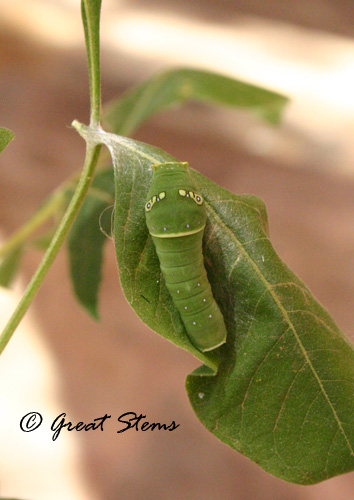 Here in Central Texas, some of the best known butterflies are those in the Swallowtail family — they are large, beautiful, and quite mesmerizing as they flutter around the garden or into the woodlands. Two of my favorite species use the same host plant, the Wafer Ash, or Hop Tree (Ptelea trifoliata). They are the Giant Swallowtail (Papilio cresphontes), seen at the end of this post, and the Two-Tailed Swallowtail (Papilio multicaudata), the latter bearing a remarkable resemblance to the Eastern Tiger Swallowtail.
Here in Central Texas, some of the best known butterflies are those in the Swallowtail family — they are large, beautiful, and quite mesmerizing as they flutter around the garden or into the woodlands. Two of my favorite species use the same host plant, the Wafer Ash, or Hop Tree (Ptelea trifoliata). They are the Giant Swallowtail (Papilio cresphontes), seen at the end of this post, and the Two-Tailed Swallowtail (Papilio multicaudata), the latter bearing a remarkable resemblance to the Eastern Tiger Swallowtail.
In the above picture and next several photos, you can see the different stages of the Two-Tailed Swallowtail caterpillars. Caterpillar growth stages are called instars. The Two-Tailed’s fifth instar stage is its final one.
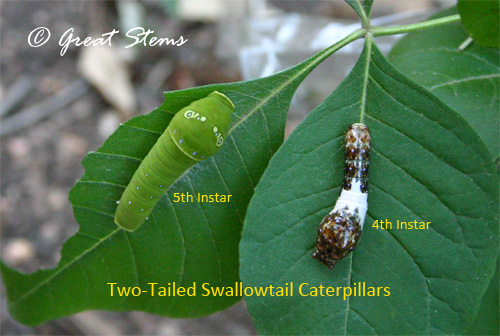
When the caterpillar is young, it looks a little like bird droppings, as do many other caterpillars in the Swallowtail family.
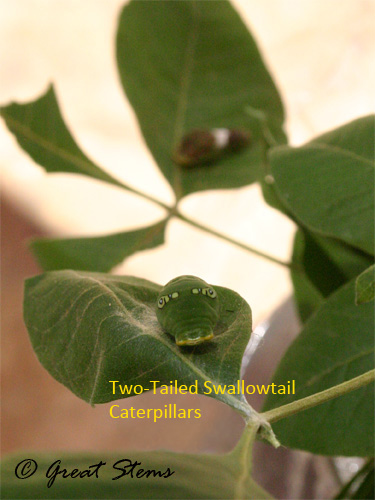
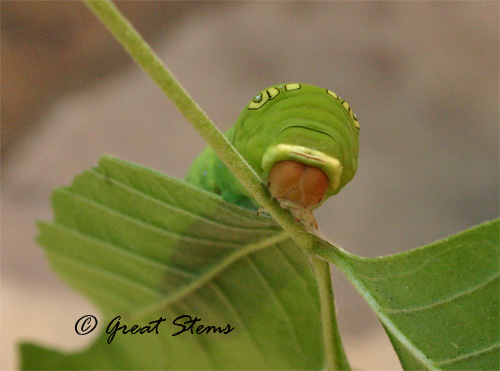
But in the transition to fifth instar, the caterpillar changes dramatically to a beautiful lime green color, with eye spots and a black band.
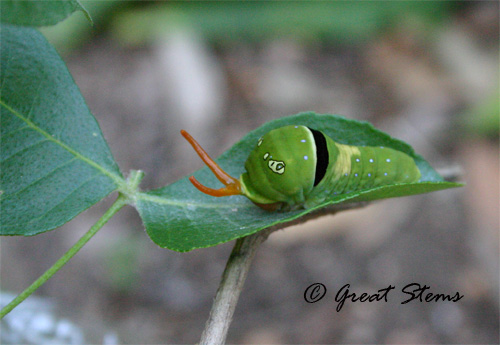 This early fifth-instar caterpillar is showing its osmeterium, a defensive response of a Swallowtail caterpillars when they feel threatened. I discourage anyone from deliberately stressing a Swallowtail caterpillar to make it show its osmeterium. This caterpillar only showed its osmeterium because I was nudging it to move to fresh foliage. You can tell the caterpillar is an early fifth instar because evidence of its once-white saddle is still visible on its back — in time the saddle area will be as green as the rest of the caterpillar.
This early fifth-instar caterpillar is showing its osmeterium, a defensive response of a Swallowtail caterpillars when they feel threatened. I discourage anyone from deliberately stressing a Swallowtail caterpillar to make it show its osmeterium. This caterpillar only showed its osmeterium because I was nudging it to move to fresh foliage. You can tell the caterpillar is an early fifth instar because evidence of its once-white saddle is still visible on its back — in time the saddle area will be as green as the rest of the caterpillar.
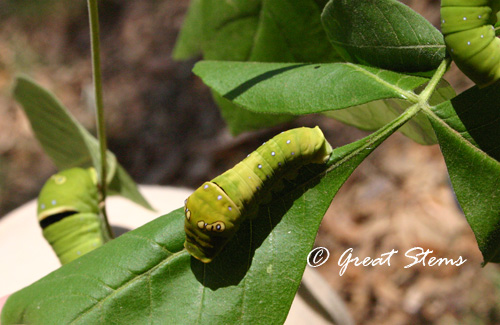
Another early fifth instar shows its somewhat mottled coloration as it transitions to full green.
A late fifth instar turns brown, and then the quest is on for an ideal, secluded chrysalis spot.
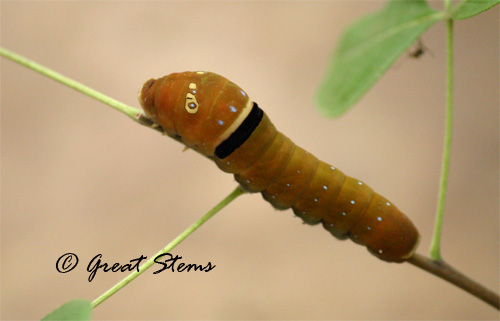
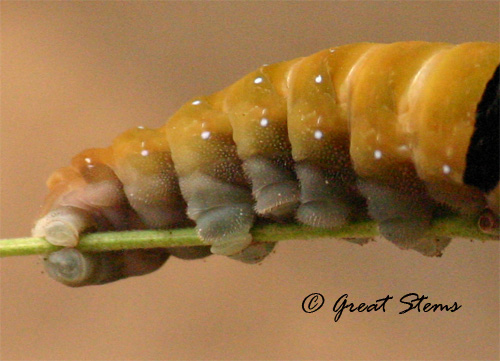 Its nifty feet will transport the caterpillar quickly. I never tire of watching the movements of a caterpillar.
Its nifty feet will transport the caterpillar quickly. I never tire of watching the movements of a caterpillar.
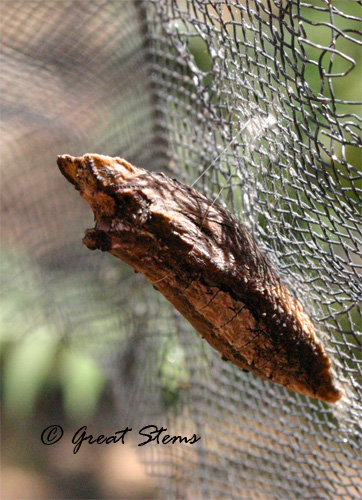
The Two-Tailed Swallowtail can take many months before it emerges from its chrysalis. So don’t hold your breath for a photo any time soon! But I look forward to that follow-up post.
Moving on to the Giant Swallowtail, I get to start first with the eggs this time. A Giant Swallowtail egg is a tiny orange sphere that darkens with time. There are two in the image below. Guess which one hatched first.
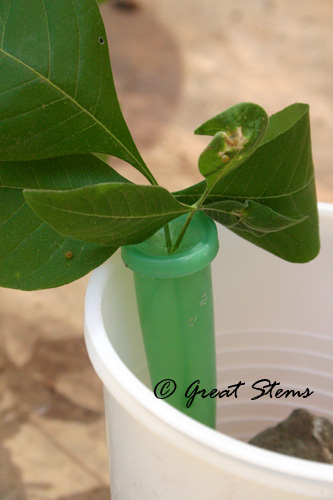 Note the foliage setup at this point — I collected the leaves with eggs and placed the petioles in a little floral water tube, making sure there were plenty of extra leaves to fill the space in the hole. The advantage to this is that the eggs and tiny caterpillars get their own area in the Caterpillar Hotel — the larger Swallowtail caterpillars would eat the eggs (and baby caterpillars) if they ran across them on their leaves, so it’s best to keep the “nursery” leaves out of their reach.
Note the foliage setup at this point — I collected the leaves with eggs and placed the petioles in a little floral water tube, making sure there were plenty of extra leaves to fill the space in the hole. The advantage to this is that the eggs and tiny caterpillars get their own area in the Caterpillar Hotel — the larger Swallowtail caterpillars would eat the eggs (and baby caterpillars) if they ran across them on their leaves, so it’s best to keep the “nursery” leaves out of their reach.
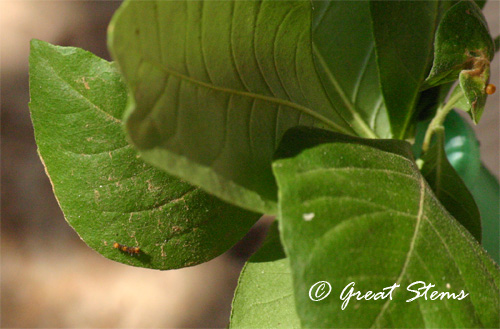 When the baby caterpillar emerges from the egg, it consumes the remaining shell before getting its first taste of the host plant. Can you see the tiny caterpillar as well as the second egg?
When the baby caterpillar emerges from the egg, it consumes the remaining shell before getting its first taste of the host plant. Can you see the tiny caterpillar as well as the second egg?
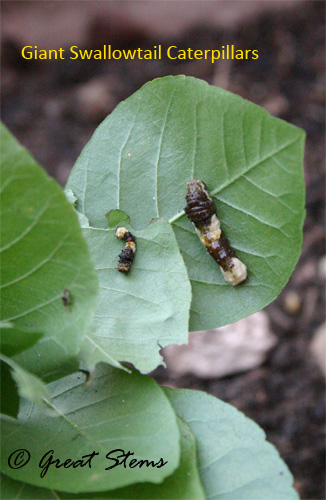 Almost two weeks later, the first caterpillar is about 1/2-inch long, and the second egg’s caterpillar is now the tiny one — both officially are looking like bird poop. They are just a few days apart in age. FYI, even though I grouped them for the photo, it’s best to keep young caterpillars separated if you can. They sometimes don’t play nicely if they happen upon one another.
Almost two weeks later, the first caterpillar is about 1/2-inch long, and the second egg’s caterpillar is now the tiny one — both officially are looking like bird poop. They are just a few days apart in age. FYI, even though I grouped them for the photo, it’s best to keep young caterpillars separated if you can. They sometimes don’t play nicely if they happen upon one another.
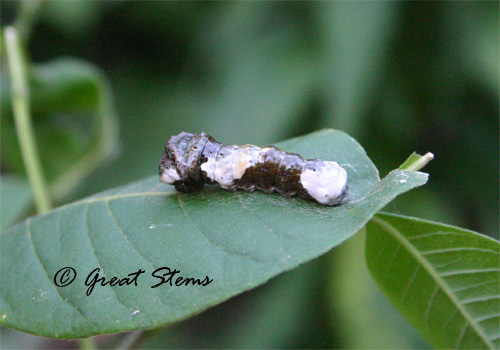
A slightly larger Giant Swallowtail really exhibits that bird poop look.
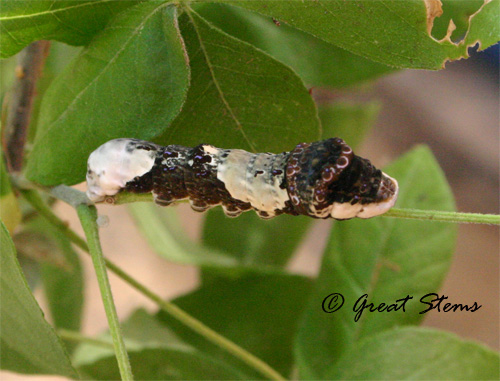
The final instar means its time to go to chrysalis.
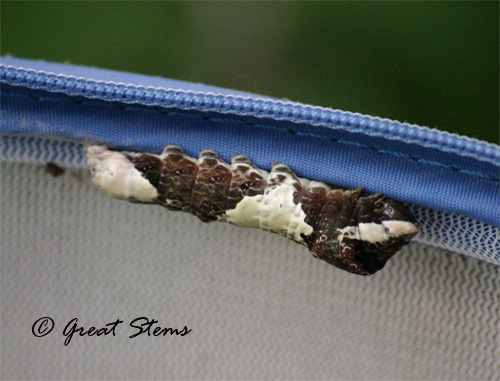
Up to the top of the hotel the caterpillar climbs. The hotel is getting as crowded as if it were SXSW in Austin.
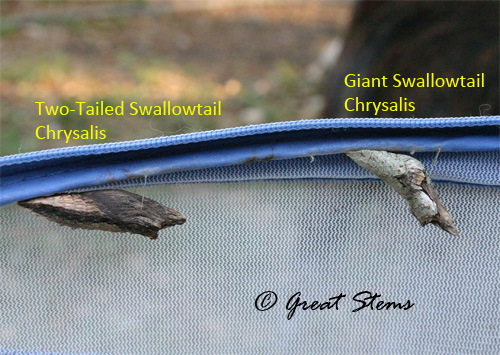 Here are the two species’ chrysalises side by side. Remarkably different, eh?
Here are the two species’ chrysalises side by side. Remarkably different, eh?
And as another comparison, here are the Giant and Two-Tailed caterpillars side by side.
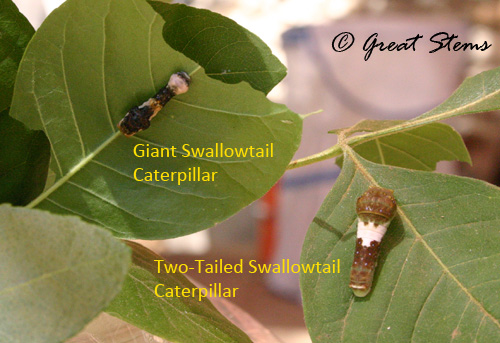
Note the difference in coloration, particularly at the end of the caterpillars. The Giant has two large areas of white, while the Two-Tailed primarily has just the saddle on its back.
We have one more species in the hotel right now — not a swallowtail, but a Gulf Fritillary.
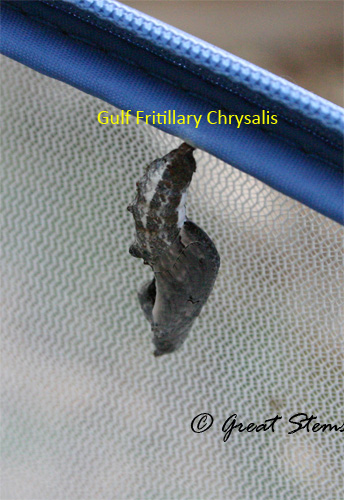 Normally we have many, many Gulf Fritillary caterpillars on the Passionvine, but I happened to be out by the vine when I saw a hunting wasp getting really close to this one. I had to save the little guy, and within a day it went to chrysalis in the hotel.
Normally we have many, many Gulf Fritillary caterpillars on the Passionvine, but I happened to be out by the vine when I saw a hunting wasp getting really close to this one. I had to save the little guy, and within a day it went to chrysalis in the hotel.
The Caterpillar Hotel is simply a collapsible mesh laundry hamper. There are some very nice butterfly tents on the market, including ones with side openings, but the laundry basket was only $10 and thus much more reasonable for the budget-minded.
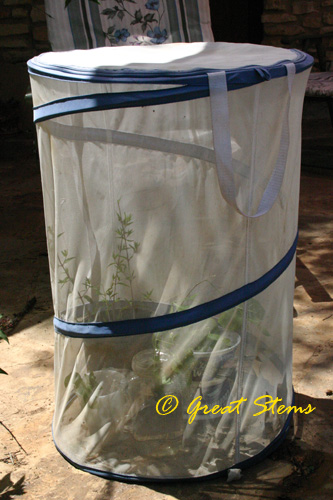
If you look inside, you can see the different methods I’ve experimented with for keeping the foliage fresh. Aside from using the floral water tube for small caterpillars and eggs on single leaves or leaflets, I like sticking leaf stalks and branches directly into damp soil. The leaves stay fresh, it’s easy to add water or replace foliage, and the caterpillars can crawl safely over the surface.
I can’t recommend the jar of water with a plastic wrap cover (held by a rubber band with foliage stalks or branches poking through a hole in the center). If the hole rips too wide, a caterpillar could fall into the water. I almost had two caterpillars drown when they got zealous in their foliage feasting and fell into the water — luckily I saw them in time (barely) and they survived (and are in chrysalis stage as I write this). Needless to say, I don’t use the jar method anymore. I also don’t like to place leaves in a bowl with little caterpillars — the leaves dry out too fast. Floral water tubes and damp soil in a planter are it for me now!
I’ll continue to play nanny to the young caterpillars, protect the chrysalises, and patiently wait for new butterflies to emerge in the Caterpillar Hotel.
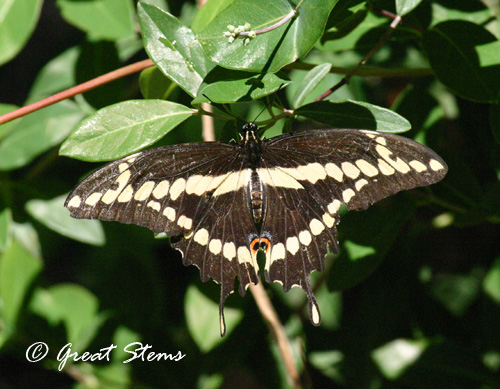
Someday, if all goes well, I’ll have giant Giants (like the one above) and Two-Tails with two tails to introduce to the world!
Well, this patient monitoring both the caterpillars you have done and your explanations, I have given many ideas to carry out similar experiments. You are a very meticulous woman and the data they offer are quite interesting. It is especially curious through the whole process of growth of the caterpillar, the method of defense, and the comparative photos. Finally, swallow tail butterfly, it is clear because it says so. In my area there are genres that seem to have samples that you, even your species not found in Europe unless some migrants as Vanessa. Best Regards Meredith.
They look so sweet darting from flower to flower, making garden like paradise. They come very prepared, through all the stages of metamorphism. Great photos…
Meredith,
Really good posting. Enjoyed seeing the stages of these cats. I have seen Giant cats but not To-tailed cats. Really nice photos too.
I haven’t raised butterflies since I was a child, but it was so much fun! So good of you to give the more fragile species a safe haven to grow and metamorphose.
Those close-ups are great. I have never seen them turn orange like those you showed. I have a pretty similar post a few months ago. http://onenezz.blogspot.com/2010/12/citrus-butterfly.html
Fabulous photos and so informative!
We’re trying to raise anise swallowtails in northern California. Do you have multiple hampers, or just one?
Oh my heck! Those are AMAZING photos. Seriously. You definitely have a talent with photography. I learned so much just seeing these quirky creatures up so close. Their color; their eyes, their tentacles, etc. were really fun to see. Nice work Meredith!
Wonderful images Meredith.The sequence and detail you showed was interesting. I really liked you frugal choice for the hotel. Good thinking.
I’m so glad you all enjoyed the post and photos — I had great fun sorting through the images and can’t wait to see the butterflies that emerge. Lisa and Robb, right now I only have the single container. However, if I run out of space or need to further separate species, I’ll get another hamper or two.
Around here the black swallowtail is the common one, and I’ve raised those in jars before on store-bought parsley.
If you’ve never raised a butterfly, you should give it a try at least once. It’s fascinating, and you’ll learn a lot.
The coolest thing I learned what that the color of the nearby foliage would determine if the chrysalis was green or brown: perched on a lonely stick meant brown chrysalis, while surrounded by greenery meant green chrysalis.
Great post!
This is fabulous! Thanks for the tour between the two swallowtails. Sometimes I protect the plant with netting to spare them but I love your butterfly safety tent. Especially valuable for documenting each stage. I remember well sitting with a video camera for almost 24 hours a day in my house to nab a Gulf fritillary emerge from a chrysalis. I slept on the floor and whenever I thought it was close, I set the alarm clock to go every hour or so. I missed one when I went to the bathroom. After that I hit the record button on the camera if I ever had to leave. It’s fun!
we are in wisconsin and just found an eastern swallowtail caterpillar today, and it’s starting to turn dark, so i think it’s ready to spin. we have hatched many monarchs over the years but never a swallowtail. which leaves shall we feed it? do they like to hang on top of a screen like the monarchs do? how long does it pupate before hatching?
THANK YOU!
Hi, Mindy. Sorry for the delay — I just got back from vacation with the kids. How exciting that you found an Eastern Swallowtail caterpillar!. If it was pretty big and turning dark, it probably was already looking for a place to form its chrysalis, but if it were still hungry, its host plant would likely be Cherry or Ash, or maybe Willow, Elm, Poplar, Maple, Spicebush — a few others, as well. The caterpillar will most likely want to form its chrysalis on a vertical or tilted stick or stem, so if you create a caterpillar hotel, you might put some long sticks in there with it, though it’s possible it will just go to the top like my other swallowtails do. Good luck!
Pingback: Orange Dog | What's That Bug?
Thanks for sharing all this information. I have host plants from Sulfurs, Gulf Fritillaries, Zebra Longwings, Julias, Monarchs, Black Swallowtails and Giant Swallowtails. But, I have so many lizards that the cats get gobbled up pretty quickly. I have brought some inside and without a mesh, have lost the cats when they get ready to go into the chrysalis stage. I’ve also had some drownings 🙁 and some that have starved because I’ve had to leave home and thought they would be fine with a branch in the vase… I feel so guilty. I had a few small cats disappear, but have no idea what could have gotten to them inside the house. I will definitely try the laundry hamper!! and the little flower tubes? Great pics, by the way!!! I need a better camera. 🙂
The laundry hamper worked great for me. When I had to use a larger vessel of water, I stuffed dry paper towels at the neck of the container to help keep the caterpillars from falling into the water. Also, if I go out of town, I either leave the caterpillar house open to let butterflies fly out on their own or I put the little caterpillars back on the main in-ground plant so they have plenty of food. Good luck!
I may have just missed it on your post, but I’m seeing some suggestions about putting the chrysalis in the refrigerator over winter. I found three giant swallowtail caterpillars on my very small potted orange tree last week. I’m going to be moving to New Orleans from south Alabama in the next few weeks- along with the orange tree. I am planning on putting these little guys in a “nursery” (love the hamper suggestion) so they aren’t harmed in the move. Do I need to put them in the refrigerator, or can’t they just stay outside in their nursery until they emerge? They are in their natural environment after all. Also, do you have any suggestions on what I can feed them? I really don’t think my baby tree will have enough food. I’m not sure where to locate the other native plants. May end up buying another orange tree if all else fails, but thought you may know of something cheaper (or free).
Hi, Sandra. They’ll eat a variety of plants in the citrus family, but it’s possible that they might get picky if they’ve only been eating orange leaves for a while. If you are concerned about food, you might indeed need to buy another plant, or if you can find some native prickly ash trees, perhaps release them for this year and try again once you’ve moved and settled in. I don’t really know about the refrigerator — I’ve never done this, as our refrigerator periodically freezes things. I’d probably let them stay outside and be conditioned to the elements. Good luck with your move! Thanks for caring for some of my very favorite butterflies/caterpillars!
Thanks for the great info on this page. I’ve raised Monarchs and Gulf Fritillaries before, but this is my first year raising Giant Swallowtails. Like the other Sandra above, I was running low on orange tree to feed to my swallowtails. My local native nursery/butterfly experts told me Giant Swallowtails and Eastern Swallowtails will also feed on rue, which is a small decorative herb-like plant about the size of parsley. I bought one, and, within a couple of days, the egg on it hatched out to a giant swallowtail caterpillar, who has been happily feeding away on that plant for several days now. So other Sandra may want to purchase a few rue plants to supplement her orange trees. I was told that rue is not edible for humans, some people get severe photosensitivity after touching the oil on the leaves, and the oil can cause liver damage to pets when ingested in large enough quantities, so be careful touching it or planting it outside if you have outdoor pets who might chew on it. It’s a pretty little plant, though.
That’s great advice. I don’t usually grow rue here — I know you have to be careful with it — but perhaps it’s a perfect solution when you need more food for the baby Giants. Thanks, Sandra W.!
Oh, I forgot to mention that they apparently will also feed on Hercule’s Club, though I honestly don’t know what that plant looks like myself.
That one I do grow here! Well, I grow the prickly ash called by that name — there’s another species called Hercules’ Club that I don’t grow.
Really enjoyed reading your post! My daughter and I discovered what we think is a giant swallowtail caterpillar going to chrysalis on her daycare’s block wall. I really want to move it into our butterfly habitat so she can see a different butterfly hatch (we hatched painted ladies a few months ago), but I’m worried about moving him. Should I do it sooner (before the chrysalis is finished) or later, or should I leave him? It’s a block wall, not foliage. I think he fell off the lemon tree above the wall. Thanks!
Hi, Suzanne. By now you’ll have figured out your own solution or have already had your butterfly emerge, but generally speaking I don’t like to move chrysalises (or transforming caterpillars). I’ve had to do that on rare occasion, and sometimes it’s a disaster. There’s information online about different techniques, and I caution you that you have to be very, very careful. Sometimes it’s best and easiest to just monitor nature as it takes its course outside — that’s a lesson in itself!
Interesting stuff; thanks.
Do you know where I can find information about the predators of the giant swallowtail caterpillars? I think birds eat them; what else? Any mammals? Does anything eat the chrysalis?
I hope your reply will also be sent to my email address.
Many thanks.
Regards,
Charles Hill
I’ve seen wasps and predatory stink bugs go after them, Charles. I imagine birds would to, particularly if they noticed them after the camouflaged stages. Beyond that, I’m not really sure.
Okay, thanks.
My lemon tree had about about 6 giant swallowtail caterpillars happily munching away and growing quite large. Three formed chrysalis. Then within a day or so, one chrysalis disappeared, as did all the other caterpillars. I saw no evidence on the ground.
I saw at least one green lizard in the tree during this time. No sign of it now; because of the lack of caterpillars?
I visit the tree maybe three times a day for a total of maybe 20 minutes. That’s not much time. But I haven’t seen any birds around the tree.
What about mammals? Do they prey on caterpillars or chrysalis? There are cats, squirrels, opossums, and raccoons (that I know of!—there may be other critters around).
Any suggestions, stories, or advice for figuring out what is going on will be greatly appreciated.
Many thanks.
Regards,
Charles Hill
I found a tiny swallowtail caterpillar on my parsley today and collected it to a new home inside. Will take it to my classroom on Tuesday to join my monarch chrysalises. Worried about the swallowtail as I’d think it would remain in chrysalis form all winter. Would like to keep it safe rather than do harm. Read all if your page. Thinking the re fridge is not a good choice but hate to think of it out in the harsh winter. Any ideas ?
Forgot to say I am in Wisconsin
Hi, Cindy. I’m not an expert, but I tend to let nature take its course. Animals usually instinctively know what the right thing to do is. If they need to overwinter, they’ll seek cover where they need to, or they’ll complete their life cycle quickly, possibly leaving eggs behind for the next generation when conditions are better. Some animals can be kept cool, but I’d worry that that long in the fridge might desiccate it or (in our case) freeze it — our fridge is rather unpredictable. Do you have an entomologist in your area that you can contact for more advice? I’d be interested hearing what you find out.
Meredith:
These are great pictures! It looks like Wafer Ash does well in your area. Here in Houston it seems to grow very slow. I have not seen either one of these species on my Wafer Ash. My mother lives around 100 miles west of me. Maybe I will plant some there to see how well it would grow and how much of interest it may gain. Keep protecting our valuable wildlife!
Tim.
Timothy, it could be that they prefer other kinds of plants in the same family in your area if they are readily available — actual citrus fruit trees or Prickly Ash (Toothache Tree), perhaps.
Thank you so much for this wonderful information! I bought a new Navel orange plant, that I just transplanted into my backyard in AZ. I noticed several caterpillars eating the leaves and many eggs on the leaves too. I realize now that they are Swallow tail caterpillars (orange dog) I was going to spray insecticide, but once I realized what they were I wanted to watch them grow. Its a new plant and I dont want it destroyed. What I have done is use an old plastic fish tank. I plucked the leaves which had the caterpillars in various stages and put them in. Now the leaves have dried out and there are many of them in my own tank hotel. I have some questions I am hoping you can help with:
1. Will they do better if I bring them into the house…or is it best to leave them outdoors. I have kept them on the ground near the plant. (its getting pretty hot and its just the beginning of april!)
2. If I just pluck a twig from the navel tree and put it in some soil in a container in the tank, will it stay fresher?
3. Do I need to put some water in there? a few drops. Do they know how to get to it?
4. I just moved their leaves into the tank yesterday. How can I tell if they are still alive? (some have climbed the walls…can I put in some twigs for them to climb up?)
Sorry to inundate you but I am excited about them but have no idea how to help them survive. Any tips/answers will be much appreciated.
Thanks so much!
Shachi, sorry for the delay in responding. What a busy spring I’ve had! When I raise caterpillars, I usually try to keep them in natural temperatures, so outside and shaded if possible. Inside, the a/c keeps the air too dry and cool, so the caterpillars don’t seem as active. A fresh twig will need to be in very moist soil but is more likely to dry out quickly than if put in water — but if you use straight water, you’ll need to create a barrier to keep the caterpillars from falling in and drowning. The caterpillars won’t drink the water but will get necessary moisture from the leaves. If the caterpillars have crawled up the sides of their temporary habitat but aren’t ready to pupate, you mainly just want to make sure they can crawl and reach their food source (again, without drowning). They’ll find it, but if you are worried, you can help them get back on the twigs.
Thank you very much for this information and Wonderful story. I raise my little caterpillar from egg. At first i’m not sure what the Specie is it, but now i know. 🙂 Thanks a lot. I’m from Thailand and i saw this egg on my Kaffir lime tree. 6 Caterpillars O.O!! but all of them so cute. They are Two-Tailed Swallowtail caterpillars 😀
That’s wonderful, Bella! I agree — I think they are very cute!